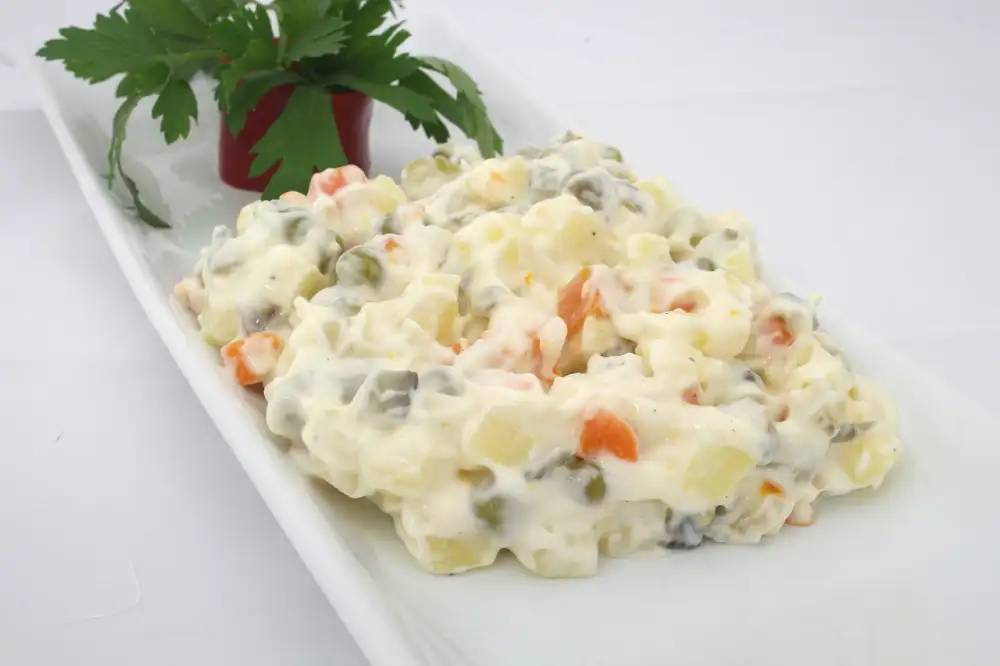Master the Art of Homemade Mayonnaise: A Step-by-Step Guide for Foodies

Homemade mayonnaise is a versatile and delicious condiment that can elevate any dish. Unlike store-bought versions, making your own mayo allows you to control the ingredients and customize the flavors to suit your taste. With just a few simple steps, you can create a creamy and flavorful spread that will take your culinary creations to the next level. In this step-by-step guide, we will walk you through the process of mastering the art of homemade mayonnaise. Get ready to embark on a flavor-filled journey!
Gather the necessary ingredients
To master the art of homemade mayonnaise, it is essential to gather all the necessary ingredients before you begin. Here's what you'll need:
1. Egg yolks: Use fresh eggs for the best results. Separate the yolks from the whites and discard the whites or save them for another recipe.
2. Mustard: Choose your favorite type of mustard, whether it's Dijon, yellow, or whole grain. This adds a tangy flavor and helps emulsify the mayo.
3. Oil: Opt for a neutral-tasting oil like vegetable or canola oil. You can also experiment with different oils such as olive oil or avocado oil to add unique flavors.
4. Salt: Enhance the taste of your mayo with a pinch of salt. Adjust according to your preference.
5. Pepper: Add a dash of freshly ground black pepper to give your mayo a subtle kick.
6. Lemon juice: Freshly squeezed lemon juice adds brightness and acidity to balance out the richness of the mayo.
By gathering these simple yet crucial ingredients, you're ready to embark on your journey towards creating delicious homemade mayonnaise that will elevate any dish it accompanies.
Prepare the equipment
Before you begin making homemade mayonnaise, it's important to have all the necessary equipment ready. Here's what you'll need:
1. A medium-sized mixing bowl: Choose a bowl that is large enough to comfortably whisk the ingredients without splattering.
2. Whisk or hand mixer: You can use either a wire whisk or a hand mixer to combine the ingredients. If using a hand mixer, make sure it has a low speed setting.
3. Measuring spoons: You'll need measuring spoons to accurately measure out the mustard, salt, pepper, and lemon juice.
4. A steady surface: Find a stable surface in your kitchen where you can place your mixing bowl securely.
Having these items prepared and within reach will make the process of making homemade mayonnaise much smoother and more enjoyable. Now that you have your equipment ready, let's move on to combining the egg yolks and mustard.
Combine the egg yolks and mustard
To begin making homemade mayonnaise, you will need to combine the egg yolks and mustard. In a medium-sized bowl, add 2 egg yolks and 1 teaspoon of Dijon mustard. Using a whisk or an electric mixer on low speed, beat the yolks and mustard together until they are well combined and slightly thickened. This step is crucial as it helps to emulsify the ingredients and create a smooth base for the mayonnaise. Make sure to whisk continuously to prevent any lumps from forming. Once the egg yolks and mustard are thoroughly mixed, you can move on to the next step in creating your delicious homemade mayonnaise.
Slowly add the oil while whisking
Once you have combined the egg yolks and mustard, it's time to slowly add the oil while whisking continuously. This step is crucial for achieving the creamy texture of homemade mayonnaise.
Start by pouring a few drops of oil into the egg yolk mixture while whisking vigorously. Gradually increase the amount of oil as you continue whisking, ensuring that each addition is fully incorporated before adding more.
The key here is to be patient and take your time. Adding the oil too quickly can cause the mixture to separate and result in a runny consistency. So, slow and steady wins the race!
Continue this process until all of the oil has been added and you have a thick, velvety emulsion. The color should be pale yellow, indicating that you've successfully created homemade mayonnaise.
Remember to keep whisking throughout this entire process to ensure that everything is well combined. The constant motion helps stabilize the emulsion and prevents any separation.
If at any point you notice that your mayonnaise becomes too thick or starts to curdle, don't panic! Simply stop adding oil and continue whisking vigorously until it smooths out again. You can also add a teaspoon of warm water to help bring it back together.
Mastering the art of slowly adding oil while whisking is essential for creating a luscious homemade mayonnaise with a perfect consistency. So take your time, enjoy the process, and savor every moment as you create this culinary masterpiece.
Season with salt, pepper, and lemon juice
Once you have achieved the desired consistency, it's time to season your homemade mayonnaise. Start by adding a pinch of salt and pepper to enhance the flavors. Give it a taste and adjust the seasoning according to your preference.
To add a tangy twist, squeeze in fresh lemon juice. The acidity will brighten up the flavors and give your mayonnaise a refreshing kick. Be careful not to add too much lemon juice as it can overpower the other ingredients.
Remember, seasoning is subjective, so feel free to experiment with different herbs and spices to customize your mayo. You can try adding garlic powder, paprika, or even a dash of hot sauce for some extra heat.
Don't be afraid to get creative and make this homemade condiment truly your own. Seasoning is what elevates your mayo from ordinary to extraordinary!
Adjust the consistency if needed
Adjust the consistency of your homemade mayonnaise if needed. If the mayonnaise is too thick, you can add a little bit of water or lemon juice to thin it out. On the other hand, if it is too thin, you can whisk in a little more oil to thicken it up. Remember to make these adjustments gradually, as a little goes a long way. The goal is to achieve a smooth and creamy texture that spreads easily. Keep tasting and adjusting until you reach your desired consistency.
Store the mayonnaise in airtight containers
Once you have made your homemade mayonnaise, it is important to store it properly to maintain its freshness and flavor. Transfer the mayonnaise into clean, airtight containers. Glass jars with tight-fitting lids work well for this purpose. Make sure the containers are thoroughly cleaned and dried before use. Store the mayonnaise in the refrigerator, where it will stay fresh for up to one week. Avoid leaving it at room temperature for extended periods as this can lead to spoilage. Always check for any signs of mold or off-putting odors before using the mayonnaise. Enjoy your homemade creation within its shelf life and savor every creamy spoonful!
Tips and variations for homemade mayonnaise
1. Experiment with different oils: While traditional mayonnaise is made with vegetable oil, you can try using olive oil, avocado oil, or even sesame oil for a unique flavor twist.
2. Add herbs and spices: Customize your mayo by adding fresh herbs like basil, dill, or chives. You can also spice it up with garlic powder, paprika, or cayenne pepper for an extra kick.
3. Make it tangy: For a tangier mayo, substitute some of the lemon juice with vinegar or add a splash of apple cider vinegar to enhance the acidity.
4. Create flavored mayonnaise: Mix in ingredients like roasted garlic, sun-dried tomatoes, chipotle peppers, or roasted red peppers to create delicious flavored mayonnaise spreads for sandwiches and burgers.
5. Use pasteurized eggs: If you're concerned about consuming raw eggs in your mayo, opt for pasteurized eggs which are heated to kill any potential bacteria while still maintaining the creamy texture.
6. Experiment with sweeteners: Add a touch of sweetness by incorporating honey, maple syrup, or even a pinch of sugar into your mayo recipe.
7. Make it vegan-friendly: Replace the egg yolks with silken tofu or aquafaba (the liquid from canned chickpeas) to create a vegan version of mayonnaise that is just as creamy and flavorful.
By following these tips and exploring different variations, you can elevate your homemade mayonnaise game and impress your taste buds with endless possibilities.
In conclusion, mastering the art of homemade mayonnaise is a game-changer for any foodie. The process may seem daunting at first, but with practice and patience, you can create a creamy and flavorful condiment that will elevate your dishes to new heights. By using fresh ingredients and following the step-by-step guide, you can customize the flavors to suit your taste preferences. Experiment with different oils, herbs, and spices to create unique variations of mayonnaise that will impress your family and friends. So why settle for store-bought when you can indulge in the rich and velvety goodness of homemade mayonnaise? Give it a try and experience the difference for yourself!
Published: 24. 11. 2023
Category: Food



